Calhoun College
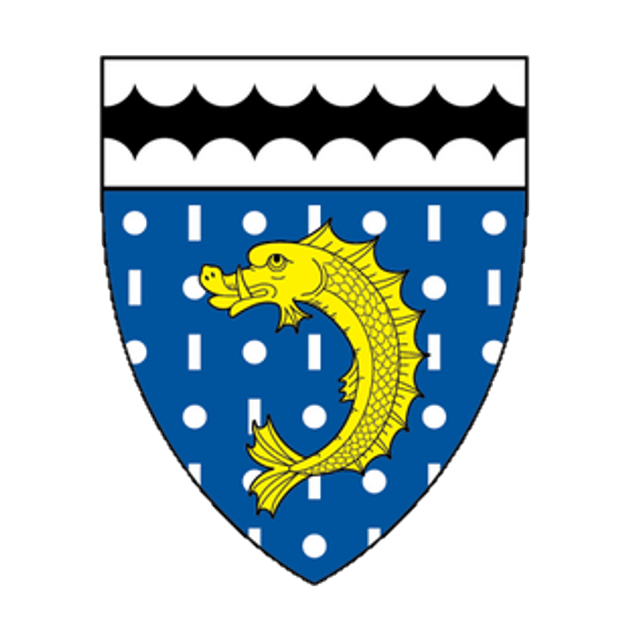
Calhoun College

| Grace Hopper College | |
|---|---|
| Residential college | |
| Yale University | |
| Location | 189 Elm Street |
| Coordinates | 41°18′36″N 72°55′38″W [44] |
| Established | 1933 (as Calhoun College) |
| Named for | Grace Murray Hopper formerly, John C. Calhoun |
| Previous names | Calhoun College |
| Architect | James Gamble Rogers |
| Sister college | Kirkland House, Harvard Pembroke College, Oxford King's College, Cambridge |
| Head | Julia Adams [1] |
| Dean | David Francis |
| Undergraduates | 425 (2013–2014) |
| Website | gracehopper.yalecollege.yale.edu [45] |
Grace Hopper College is a residential college of Yale University, opened in 1933 as one of the original eight undergraduate residential colleges endowed by Edward Harkness. It was originally named Calhoun College after US Vice President John C. Calhoun, but renamed in 2017 in honor of computer scientist Grace Murray Hopper.[2][3][4] The building was designed by John Russell Pope.
From the 1960s onward, Calhoun's white supremacist beliefs and pro-slavery leadership[5][6][7][8] had prompted calls to rename the college and remove its tributes to Calhoun. In 2016, the Yale Corporation chose to retain the Calhoun name,[9][10] but in 2017 it reversed its decision and renamed the college after Hopper. [2][3]
| Grace Hopper College | |
|---|---|
| Residential college | |
| Yale University | |
| Location | 189 Elm Street |
| Coordinates | 41°18′36″N 72°55′38″W [44] |
| Established | 1933 (as Calhoun College) |
| Named for | Grace Murray Hopper formerly, John C. Calhoun |
| Previous names | Calhoun College |
| Architect | James Gamble Rogers |
| Sister college | Kirkland House, Harvard Pembroke College, Oxford King's College, Cambridge |
| Head | Julia Adams [1] |
| Dean | David Francis |
| Undergraduates | 425 (2013–2014) |
| Website | gracehopper.yalecollege.yale.edu [45] |
History
Before the college
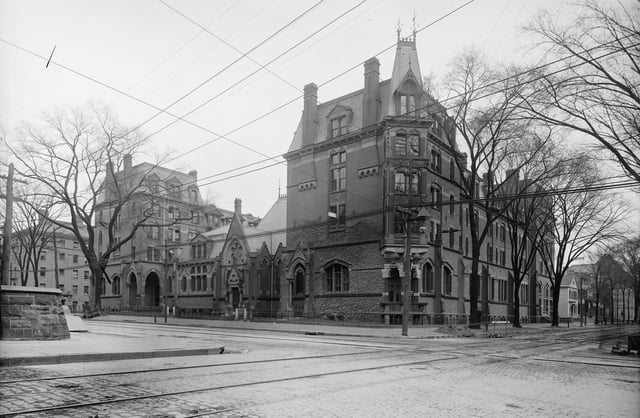
Divinity Hall, demolished in 1931 to build the college, from New Haven Green
In 1641, John Brockston established a farm on the plot of land that is now Grace Hopper College. After the Revolutionary War an inn was constructed that would later become the meeting place of the Phi Beta Kappa Society. From 1863 until 1931 the land was home to the Yale Divinity School, which was housed in three buildings known as West Divinity Hall, Marquand Chapel, and East Divinity Hall.[11] After Yale President James Rowland Angell announced the residential college plan in 1930, the Divinity School campus was demolished and a new campus built at the top of Prospect Hill, where it currently stands.
Construction and early history

Arms of Calhoun College

College courtyard, Spring 2015.
Although all the other Collegiate Gothic-style colleges at Yale were conceived by James Gamble Rogers, the commission for the new college at the corner of College and Elm Streets was given to John Russell Pope, a campus planner who concurrently designed the Payne Whitney Gymnasium.[12] The new dormitory was named Calhoun College.
Like all other residential colleges at their inception, the college had twenty-four-hour guard service and the gates were never locked. Jacket and tie was the necessary attire in the dining hall and meals were served at the table.
At first, it was considered an undesirable college because of its location at the corner of College and Elm, where trolleys frequently ran screeching around the corner. This perception changed under the popular Master Charles Schroeder, who once remarked that if the despicable trolley service were ever removed he would purchase a trolley car, put it in the courtyard, and hold a celebration to commemorate the event. The trolley system was indeed removed in 1949, and though a whole car proved unfeasible, Master Schroder secured the fare collecting machine from a trolley and made good on his promise to celebrate. Thus was born Trolley Night, a proud tradition of the college.
The coat of arms designed for Calhoun College combined the university arms, set atop the Cross of St. Andrew. The college colors were black, navy blue, and gold.
Later events
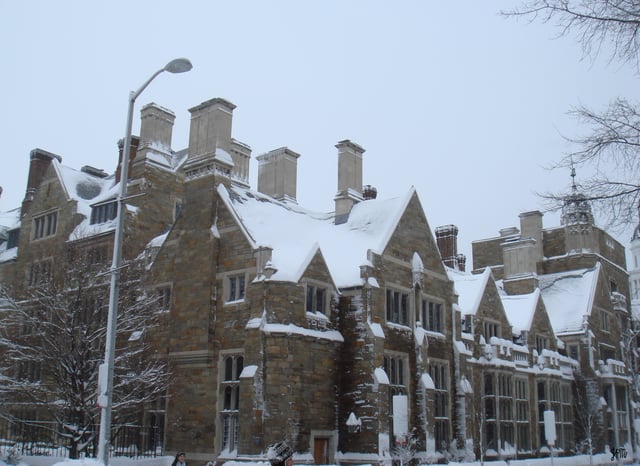
The college from Elm Street
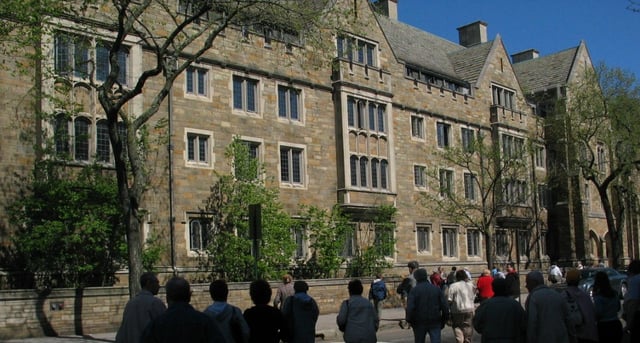
The College Street frontage
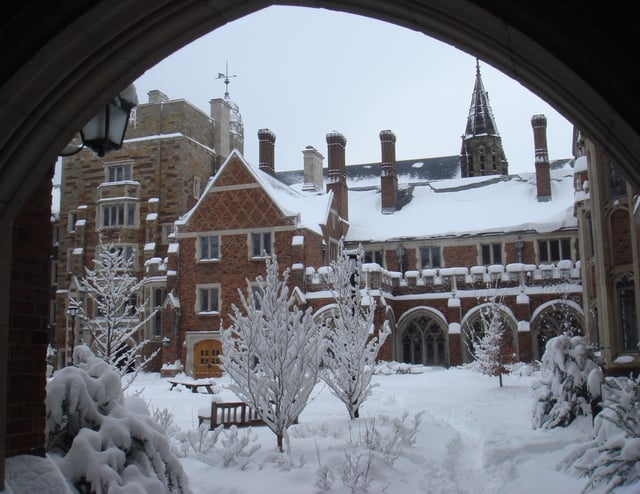
College courtyard, Winter 2011.
In 1989, Calhoun was the first residential college to be renovated. The renovations, mostly funded by alumnus Roger Horchow, were done quickly and over the summer to minimize disruption to student life, and by 2000, the physical plant began to show wear and tear again.
2005 saw the retirement of William and Betsy Sledge as Master and Associate Master. They were succeeded by Dr. Jonathan Holloway (PhD '95) and his wife Aisling Colón. In 2014, Holloway became the Dean of Yale College, the first African-American to hold that position. He was succeeded as Master by Julia Adams, Professor of Sociology and International and Area Studies. In the same year a limited window replacement was commissioned amid controversy over the college's exclusion from the most recent campus-wide renovation effort.
Stephen Lassonde stepped down as dean in June 2007 thus ending one of the longest tenures in the college's history. Within the Residential College system at Yale, deanships normally last only a few years, but Stephen Lassonde served as Calhoun Dean for fourteen years.[13] In late April 2007, he made the official announcement that he would be leaving the college to serve as Deputy Dean of the College at Brown University in nearby Providence, Rhode Island. He was succeeded by Leslie Woodard, who died unexpectedly at her home at the college in October 2013.[14] Until June 2007 Dean Woodard was the director of the undergraduate creative writing program at Columbia University. A published author of short stories, Dean Woodard also had a history in the performing arts; she was a professional dancer in the Dance Theater of Harlem for a decade.
In late June 2007 the college's mighty elm, which had provided shade since the college's foundation and also supported the college's famous tire swing, was felled. The tree was rotting from the ground up and was beginning to lean dangerously. Given the fact that the tree was actually taller than the college (itself a five- and six-story building in different places), the tree posed a real danger to the college structure and students.
The college was eventually fully renovated over the 2008-09 school-year.
Namesakes and Calhoun controversy
John C. Calhoun
John C. Calhoun grew up on a plantation in South Carolina. He entered Yale College in November 1802 [15] and lived in a dorm on the college's Old Campus, Union Hall. His professors included Benjamin Silliman, and Yale Presidents Jeremiah Day and Timothy Dwight.[16] He did well academically, was selected as a member of the Linonia literary society, and graduated Phi Beta Kappa in 1804.[17] He subsequently received a Juris Doctor from Litchfield Law School in Connecticut, and thereafter returned to South Carolina. After his student years, Calhoun never again had significant involvement in Yale and was never a benefactor.
Elected to the United States Congress in 1810, he made his name as a War Hawk before the War of 1812, then became Secretary of War under President James Monroe. He was elected Vice President in 1825 and served two terms before resigning to fight for South Carolina's nullification of federal tariffs as a Senator. During his political career, Calhoun gained a reputation as a great rhetorician and intellectual. In addition to his advocacy of states' rights, Calhoun was a proponent of slaveholder rights and believed that slavery was justified by white supremacy. Inheriting his father's farm, Calhoun remained a slaveholder his entire life and profited from the cotton trade.
Naming of Calhoun College
Because of his political, military, and intellectual achievements, Calhoun was venerated as an illustrious Yale alumnus beginning in the mid-nineteenth century. He was the only Yale graduate to be elected to a federal executive office in the school's first two centuries, until the election of U.S. President William Howard Taft in 1909. A 1914 biography of Calhoun by Yale Secretary Anson Phelps Stokes details his accomplishments as an "eminent Yale man" without once mentioning his slaveholdings or pro-slavery leadership.[18]
Already holding some of Calhoun's papers, Yale offered its first commemoration of Calhoun during the construction of the Memorial Quadrangle in 1917. Statues of eight pre-20th century "Yale worthies" were placed on Harkness Tower, including an eight-foot statue of Calhoun.[19] Of these, only Calhoun and Jonathan Edwards were selected as namesakes of the eight original residential colleges when they were named around 1931.
Re-naming debates
A debate over the appropriateness of the college's name has waxed and waned, as John C. Calhoun's involvement in defending slavery has been reconsidered. In 1992, the graduating seniors commissioned a plaque noting the unfortunate reality of John C. Calhoun's legacy, but at the same time supported the notion that the college retain its name for historical purposes.[20] Around the same time, a pane of stained glass in the college's common room depicting a shackled black man kneeling before Calhoun was altered to depict Calhoun alone.[21]
After the June 2015 Charleston church shooting, radio commentators Colin McEnroe and Ray Hardman questioned whether the preservation of the college's name was an inappropriate legacy of white supremacy.[22][23] The events, which instigated student protests and alumni petitions in the same year,[6] caused administrators to consider renaming the college. In their petition students argued that—while Calhoun was respected in the 19th century as an "extraordinary American statesman"—he was "one of the most prolific defenders of slavery and white supremacy" in the history of the United States.[6][7] In August 2015 Yale President Peter Salovey addressed the Freshman Class of 2019 in which he responded to the racial tensions but explained why the college would not be renamed.[8] He described Calhoun as a "a notable political theorist, a vice president to two different U.S. presidents, a secretary of war and of state, and a congressman and senator representing South Carolina."[8] He acknowledged that Calhoun also "believed that the highest forms of civilization depend on involuntary servitude. Not only that, but he also believed that the races he thought to be inferior, black people in particular, ought to be subjected to it for the sake of their own best interests."[5][24]
In April 2016 Salovey announced that "despite decades of vigorous alumni and student protests," Calhoun's name would remain on the Yale residential college.[9] Salovey argued that it was preferable for Yale students to live in Calhoun's "shadow" so they will be "better prepared to rise to the challenges of the present and the future." He claimed that if they removed Calhoun's name, it would "obscure" his "legacy of slavery rather than addressing it."[9] "Yale is part of that history" and "We cannot erase American history, but we can confront it, teach it and learn from it." At the same time, Salovey announced that the title of “master” would be changed to “head of college” because of the title's freighted use by American slaveowners.[10][25][26]
Artistic depictions of antebellum slavery
Stained glass window panels in the college depicted images of slavery. One showed a black man in shackles kneeling before Calhoun. Temple University professor and co-founder of the Yale Black Alumni Network Chris Rabb advocated for that panel to be altered.[27][28] The alterations replaced the black man with blank white pieces of glass.[29] The university had plans to change some additional stained glass windows in the dining hall in 2016, but, before that was done, Corey Menafee, an African-American dishwasher who worked there, knocked out the pane that showed black slaves harvesting cotton in the fields, because, as he related, he no longer wanted to be subjected to seeing the "racist, very degrading" image at his place of work, but also added: "There's always better ways of doing things like that than just destroying things." Menafee was initially arrested on felony and misdemeanor charges.[30][31] Yale chose not to press charges which were then dropped and, after initially accepting Menafee's resignation, rehired him to work at a different location.[32]
Calhoun's name has been tied up in larger controversies about the associations of the colleges with slavery. A 2001 report revealed that at least seven of the colleges' namesakes were slave owners.[20] In 2009, a student group protested the connection by posting alternative names for slaveowner-named colleges near the college entrances.[33] Commenting for the Wall Street Journal, Roger Kimball pointed out that Yale's namesake, Elihu Yale, was a slave trader, and questioned how Yale can defend the name of the university against similar moral arguments.[34]
Renaming
Partly because of the controversy surrounding the 2016 decision not to rename Calhoun College, Yale put in place a policy on the potential renaming of buildings and other institutions around the university. One of the first items of business the consequent task force addressed was the renaming of Calhoun College, and in February 2017 it recommended to the Yale Corporation that the College's name be changed.[35] The Corporation accepted that recommendation, and voted at its February 2017 meeting to change the name of Calhoun to Grace Hopper College, effective July 1, 2017.[2]
The College's new namesake has strong ties to Yale, having received her Ph.D. from there under the direction of Øystein Ore in 1934.[36]
The College's new arms, designed in 2017, were intended to represent Admiral Hopper's history, as well as to create a tie to the College's past. The heraldic dolphin represents both leadership and Hopper's career in the United States Navy. The rectangles and circles represent her contributions to mathematics and computer science. The scalloped (engrailed) bar is evocative of waves—and also incorporates a design element of the Calhoun College arms, which featured an engrailed saltire.[37]
Unique features
The courtyard used to have a popular tire swing, which stood in stark contrast to the Neo-Gothic architecture. In fall 1990, newly appointed master Turan Onat made it his first priority to remove the tire swing as he sought "to restore the courtyard to a grassier state." The seniors immediately reinstalled the swing overnight and Onat quickly reversed his policy.
The college used to be the only residential college with its own sauna.[38] The sauna was removed from Entryway B/C during the 2005-06 school year.
The College Council is a student governing organization that coordinates activities and social life for the residential college. Throughout the year, the Council organizes numerous activities including: Study Breaks, a dorm-wide dance, and Trolley Night, an annual dance party.[39]
Notable alumni
Angela Bassett, actress
John R. Bolton, National Security Advisor of the United States, attorney
David L. Boren, 1963, Governor of Oklahoma, US Senator, Chancellor, University of Oklahoma
Sandra Boynton, author
Robert Curtis Brown, actor
Jonathan Coulton, singer-songwriter
Claire Danes, actress
Mark Dayton, 1969, governor of Minnesota
Bryce Dessner, composer and guitarist with The National
Jodie Foster, 1985, actress
Henry Louis Gates, Jr., 1973, author, literary critic, professor
Paul Krugman, 1974, economist, New York Times columnist, winner of the Nobel Prize in Economics, 2008
John Hodgman, comedian
Roger Horchow, Tony Award-winning Producer and founder of The Horchow Finale
Demetri Martin, comedian
George Packer, journalist, author, playwright
Joshua Prince-Ramus, 1991, architect
Kurt Hugo Schneider, internet celebrity
Jake Sullivan, 1998, foreign policy adviser to Joe Biden and Hillary Clinton[40]